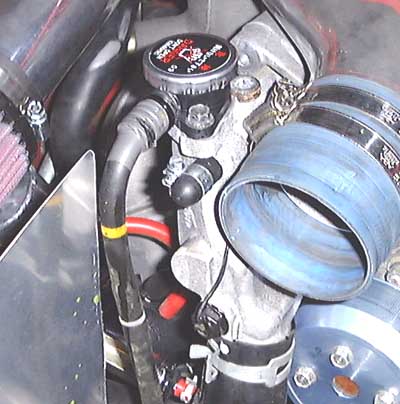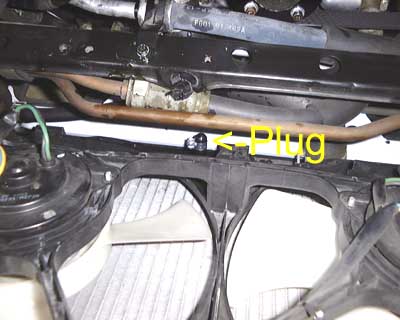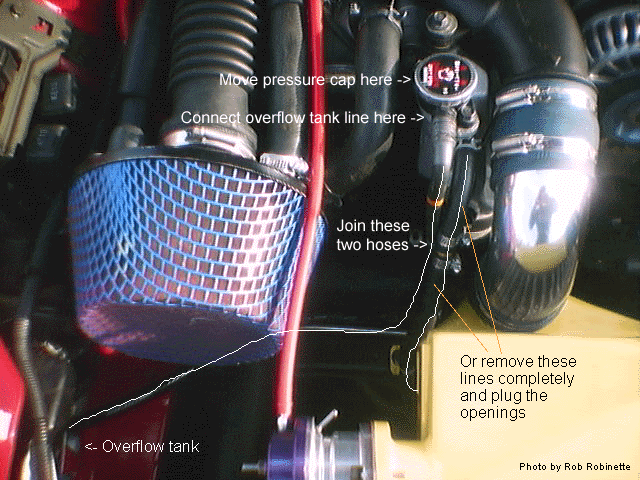How to Eliminate the Coolant Air Separation Tank (AST)
By Rob Robinette
The small black plastic air separation tank bolted to your intercooler has a habit of cracking and dumping all your coolant all over the engine compartment at the most inopportune time. It also blocks some airflow through the intercooler and allows some coolant to bypass the radiator. The tank's purpose is to remove air bubbles in the coolant system but the 1st and 2nd generation RX-7s don't have one. Someone, in a galaxy far, far away, decided to modify the system to work like the 2nd gen RX-7. It worked. There are many, many people on the RX-7 e-mail list that have done this mod with no ill effects (I did it in 97). If you are too squeamish to do this mod you can get an after-market aluminum air separation tank for around $140.
Here’s how to remove the small black plastic coolant "air separation tank."
There are two ways to do this mod, you can join the two hoses like in the photo or do it the preferred way developed by Max Cooper by removing the two hoses that flow into the bottom and middle of the AST and then plug the openings with a short piece of coolant line plugged with a bolt. Max had both his "Help!" brand rubber plugs blow within two months.
You will need two things to eliminate the tank. First one is the 1986 RX-7 "Radiator Cap Neck" with the overflow tube, part # 15-17YA-N326, $30.20 from Mazdatrix (don’t be confused by the name, the radiator cap neck doesn’t attach to the radiator, it’s the radiator cap located on the engine). You will also need a 3/8" hose coupler and two hose clamps (if you are going to join the hoses). Home Depot and Pep Boys sells a 3/8" "Camel" Hose Repair Kit ($4). It’s in the tool area with the air tool accessories. The part # on the front of the package is 52-465, the number on the back of the package is 657465 A.
The radiator cap neck swap is easy but be careful not to drop the round rubber o ring that will probably come up with the old neck. I dropped it down onto the engine compartment floor pan. I had to pull it loose to find the o ring (I was going to pull the pan anyway to remove the plastic air restrictors in the nose anyway).

Upper hose plugged (these "Help!" brand rubber plugs don't seem to hold up)
The next step is to join the hose that goes into the bottom of the air separator tank with the one that goes into the middle of the tank (or remove these hoses and plug the two openings, to plug the lower hose you'll have to remove the intercooler). The hose from the bottom of the tank should be routed so that it comes up from the bottom of the radiator to the radiator cap neck that you just swapped out. Bring this bottom hose directly up to the hose that was connected to the middle of the tank, cut them to fit, and couple them together using the 3/8" brass coupler that came in the hose repair kit. Don’t forget to put the hose clamps on before you join the hoses.
If you choose to plug these two lines (see pictures) you can access the bottom hose and nipple by dropping the plastic engine floor pan. Just remove the 2 bolts and 2 plastic plugs on the back edge and the 4 bolts on the side of the pan and it will drop down enough to access the lower radiator nipple. Kevin Kelleher used 2 bolts to plug the two AST tank lines. Get some 3/8" (or 5/16") reinforced hose (fuel line). Get two 3/8' bolts with about ¾ inch of unthreaded shank, and cut this length out of bolt, and stuff in one end of the hoses. Fit on nipples, and use hose clamps, 4 total.

